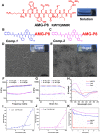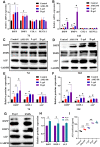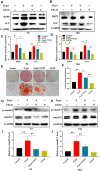An amelogenin-based peptide hydrogel promoted the odontogenic differentiation of human dental pulp cells
- PMID: 35936553
- PMCID: PMC9348551
- DOI: 10.1093/rb/rbac039
An amelogenin-based peptide hydrogel promoted the odontogenic differentiation of human dental pulp cells
Abstract
Amelogenin can induce odontogenic differentiation of human dental pulp cells (HDPCs), which has great potential and advantages in dentine-pulp complex regeneration. However, the unstability of amelogenin limits its further application. This study constructed amelogenin self-assembling peptide hydrogels (L-gel or D-gel) by heating-cooling technique, investigated the effects of these hydrogels on the odontogenic differentiation of HDPCs and explored the underneath mechanism. The critical aggregation concentration, conformation, morphology, mechanical property and biological stability of the hydrogels were characterized, respectively. The effects of the hydrogels on the odontogenic differentiation of HDPCs were evaluated via alkaline phosphatase activity measurement, quantitative reverse transcription polymerase chain reaction, western blot, Alizarin red staining and scanning electron microscope. The mechanism was explored via signaling pathway experiments. Results showed that both the L-gel and D-gel stimulated the odontogenic differentiation of HDPCs on both Day 7 and Day 14, while the D-gel showed the highest enhancement effects. Meanwhile, the D-gel promoted calcium accumulation and mineralized matrix deposition on Day 21. The D-gel activated MAPK-ERK1/2 pathways in HDPCs and induced the odontogenic differentiation via ERK1/2 and transforming growth factor/smad pathways. Overall, our study demonstrated that the amelogenin peptide hydrogel stimulated the odontogenic differentiation and enhanced mineralization, which held big potential in the dentine-pulp complex regeneration.
Keywords: amelogenin; human dental pulp cells; odontogenic differentiation; peptide hydrogel.
© The Author(s) 2022. Published by Oxford University Press.
Figures






Similar articles
-
Odontogenic Effect of Icariin on the Human Dental Pulp Cells.Medicina (Kaunas). 2022 Mar 16;58(3):434. doi: 10.3390/medicina58030434. Medicina (Kaunas). 2022. PMID: 35334610 Free PMC article.
-
Effects of phase-transited lysozyme on adhesion, migration and odontogenic differentiation of human dental pulp cells: An in vitro study.Int Endod J. 2023 Apr;56(4):475-485. doi: 10.1111/iej.13884. Epub 2023 Jan 6. Int Endod J. 2023. PMID: 36565046
-
Activation of Transient Receptor Potential Ankyrin 1 and Vanilloid 1 Channels Promotes Odontogenic Differentiation of Human Dental Pulp Cells.J Endod. 2021 Sep;47(9):1409-1416. doi: 10.1016/j.joen.2021.06.007. Epub 2021 Jun 12. J Endod. 2021. PMID: 34126160
-
Proliferation and odontogenic differentiation of human umbilical cord mesenchymal stem cells and human dental pulp cells co-cultured in hydrogel.Arch Oral Biol. 2020 Jan;109:104582. doi: 10.1016/j.archoralbio.2019.104582. Epub 2019 Oct 4. Arch Oral Biol. 2020. PMID: 31605918
-
Leptin Induces Odontogenic Differentiation and Angiogenesis in Human Dental Pulp Cells via Activation of the Mitogen-activated Protein Kinase Signaling Pathway.J Endod. 2018 Apr;44(4):585-591. doi: 10.1016/j.joen.2017.11.018. Epub 2018 Feb 1. J Endod. 2018. PMID: 29397219
Cited by
-
Effects of different signaling pathways on odontogenic differentiation of dental pulp stem cells: a review.Front Physiol. 2023 Oct 19;14:1272764. doi: 10.3389/fphys.2023.1272764. eCollection 2023. Front Physiol. 2023. PMID: 37929208 Free PMC article. Review.
-
Peptides in Dentistry: A Scoping Review.Bioengineering (Basel). 2023 Feb 6;10(2):214. doi: 10.3390/bioengineering10020214. Bioengineering (Basel). 2023. PMID: 36829708 Free PMC article.
-
Research Advances on Hydrogel-Based Materials for Tissue Regeneration and Remineralization in Tooth.Gels. 2023 Mar 20;9(3):245. doi: 10.3390/gels9030245. Gels. 2023. PMID: 36975694 Free PMC article. Review.
References
-
- Krastl G, Weiger R, Filippi A, Van Waes H, Ebeleseder K, Ree M, Connert T, Widbiller M, Tjäderhane L, Dummer PMH, Galler K.. Endodontic management of traumatized permanent teeth: a comprehensive review. Int Endod J 2021;54:1221–45. - PubMed
LinkOut - more resources
Full Text Sources
Miscellaneous

